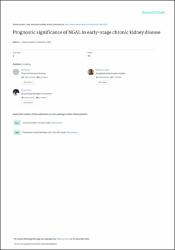Prognostic significance of NGAL in early stage chronic kidney disease

Göster/
Erişim
info:eu-repo/semantics/openAccessTarih
2017Yazar
Baştürk, TanerSarı, Özlem
Koç, Yener
Eren, Nezaket
Isleem, Mahmoud
Kara, Ekrem
Sevinç, Mustafa
Sakacı, Tamer
Ahbap, Elbis
Hasbal, Nuri B.
Bayrakdar Çağlayan, Feyza
Ünsal, Abdulkadir
Üst veri
Tüm öğe kaydını gösterKünye
Basturk, T., Sari, O., Koc, Y., Eren, N., Isleem, M., Kara, E., Sevinc, M., Sakaci, T., Ahbap, E., Hasbal, N. B., Bayrakdar Caglayan, F., & Unsal, A. (2017). Prognostic significance of NGAL in early stage chronic kidney disease. Minerva urologica e nefrologica = The Italian journal of urology and nephrology, 69(3), 307–312. https://doi.org/10.23736/S0393-2249.16.02770-3Özet
BACKGROUND: Neutrophilgelatinase-associated lipocalin (NGAL) has been proven to be a useful biomarker for early detection of acute kidney injury, but it is not known whether adding NGAL measurements to conventional risk factors will improve the risk assessment in the setting of chronic kidney disease (CKD). the aim of the present study was to examine the correlation of NGAL with early stage renal impairment in CKD and to evaluate its prognostic value in these subjects. METHODS: This is a prospective observational cohort study of 54 patients with early stage (stage 1-2) CKD. Patients aged between 18 and 65 years with stable disease were enrolled in this study. Patients with a history of primary glomerulonephritis, diabetes mellitus, acute kidney injury, systemic diseases and stage 3-4-5 CKD were excluded from the study group. Estimated glomerular filtration (eGFR) rate was calculated by Chronic Kidney Disease Epidemiology Collaboration (CKD-EPI) formula. the patients were followed for two years to determine the ability of baseline NGAL for prediction of renal outcome. in our study disease progression was defined as changes in eGFR (Delta eGFR) and proteinuria (Delta proteinuria). Patients divided into two groups according to NGAL cut-off value as group 1 (N.= 23, NGAL <= 98.71 ng/mL) and group 2 (N.= 31, NGAL >98.71 ng/mL). RESULTS: Out of 54 patients (mean age: 45.6 +/- 7.6 years, 64.8% female, baseline eGFR: 84.6 +/- 16.8 mL/min/ 1.73 m(2), baseline NGAL level: 157.47 +/- 121.52 ng/mL); 18 patients were stage 1 and 36 patients were stage 2 CKD. in the ROC analysis, we found that the optimal cut-off value of NGAL for predicting stage 2 CKD was 98.71ng/mL (P=0.005) with the 72.2% sensitivity and 72.2% specificity. in correlation analysis, we evaluated significantly positive correlations between NGAL and CKD stage (r=0.389, P=0.004), baseline/last serum creatinine level (r=0.530, P<0.001 and r=0.439, P=0.003; respectively), last proteinuria level (r=0.359,P=0.043). There were significantly negative correlation between NGAL and baseline/last eGFR (r=-0.498, P<0.001 and r=-0.462, P=0.002; respectively). Compared to the group 1, we determined that group 2 patients had further deterioration in renal functions regarding.eGFR (-1.12 +/- 12.6 mL/min vs. -1.46 +/- 12.4 mL/min: respectively, P=0.930) and Delta proteinuria (98.1 +/- 569.3 mg day vs. 339 +/- 701.6 mg/day; respectively, P=0.305); however these differences were not statistically significant at the end of the two years follow-up period. CONCLUSIONS: Altough NGAL has a positive correlation with disease severity, it does not seem to be a marker of disease progression in patients with early stage CKD. But further studies stated in different patient groups may also explain the usability of NGAL in clinical practice.

















